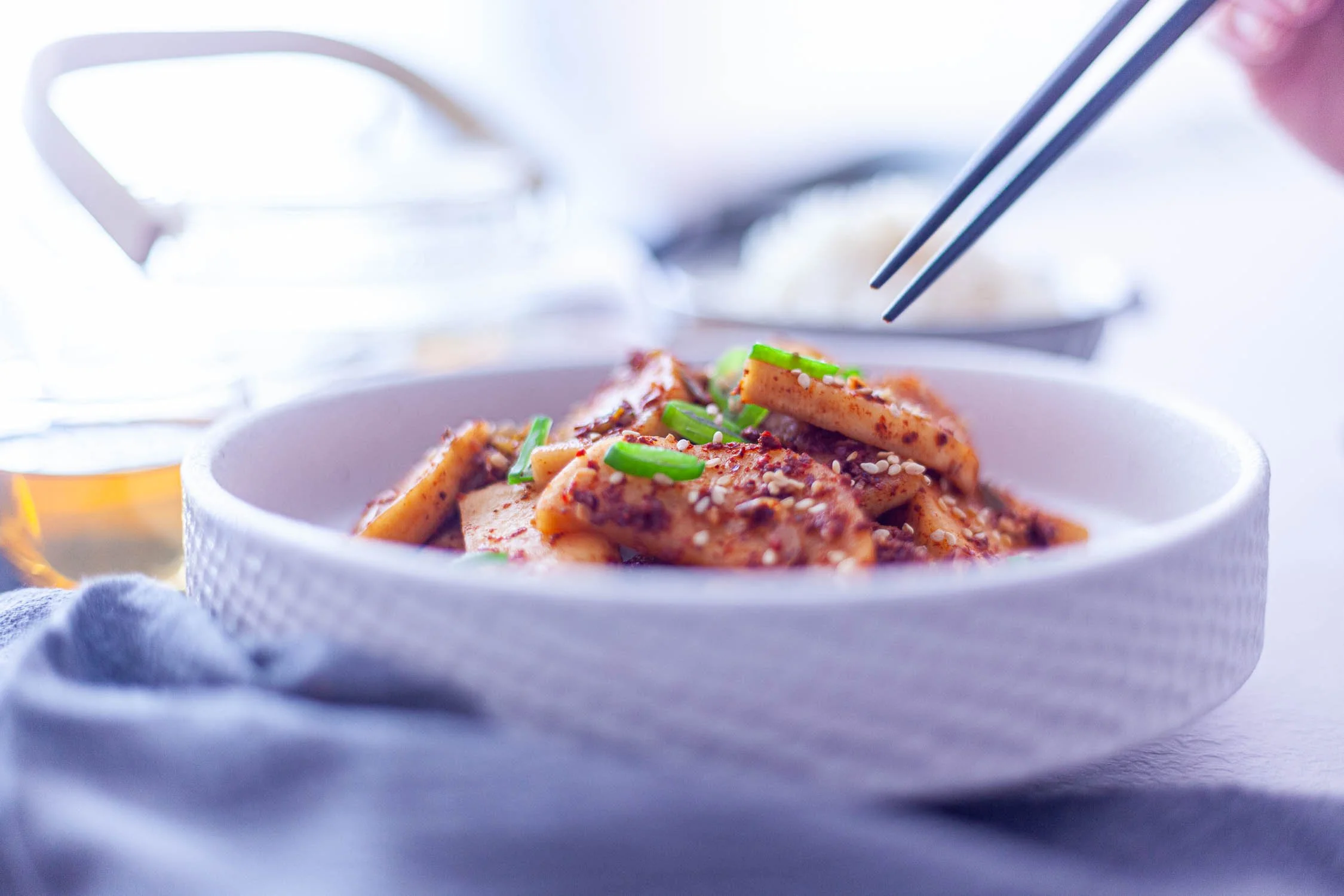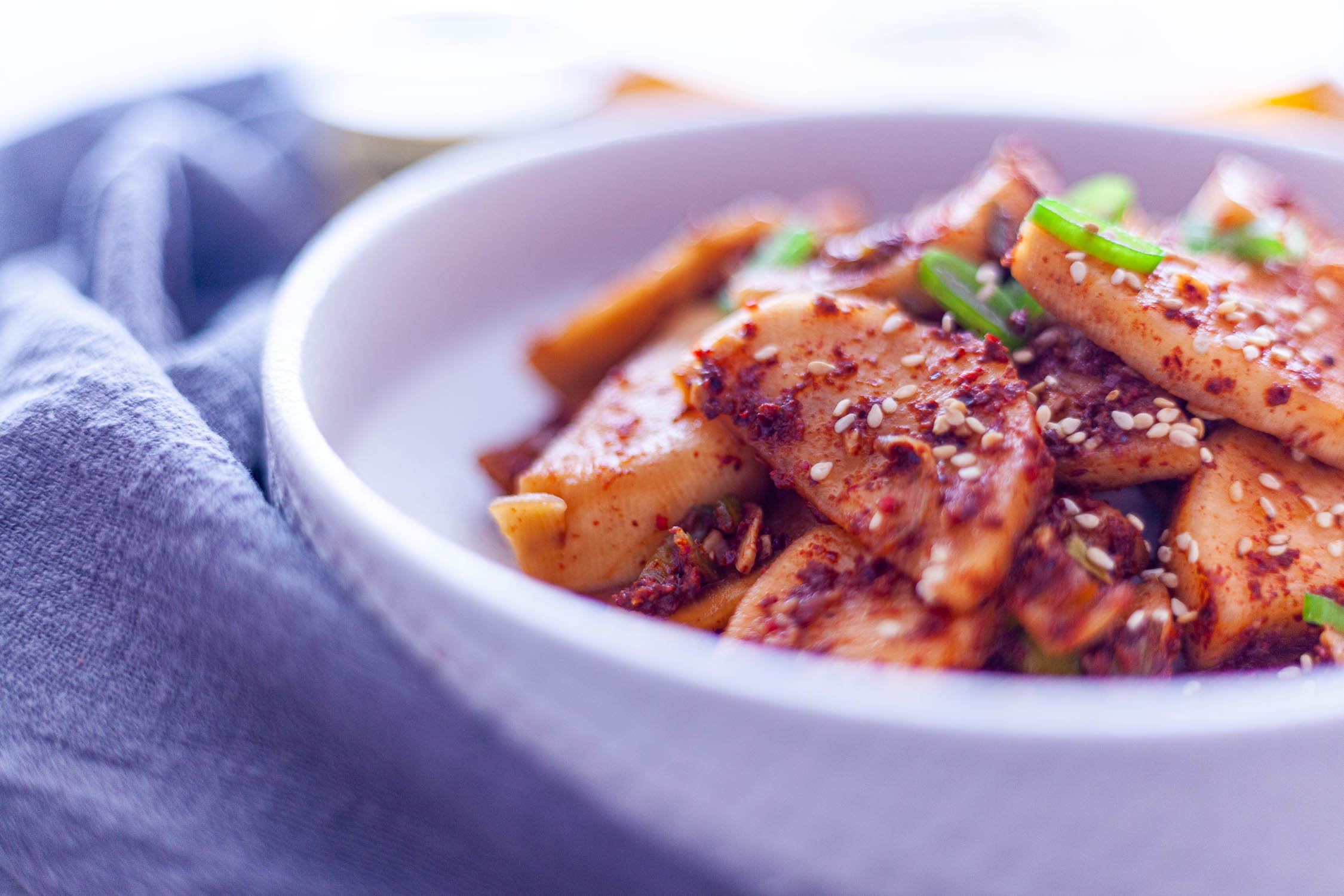A Homemade Kimchi Recipe — Radish Kimchi & My Half-Moon Smiley

make small batches from scratch easily !
Kimchi—that pungent, spicy pickle we all love from Korea. This is my take on Kimchi. Instead of using Napa cabbage, I use daikon radish. But it is not Kkakdugi, which is Korean radish kimchi in cube form. I have my version with thinly sliced radish shaped into a half-moon. Why? Just for fun…Maybe it will bring a smile to your face just like how it did for me. Other than different in shape, it tastes as delicious I promise.

The Koreans usually serve kimchi as a table condiment with Korean traditional soups, rice and other side dishes. This radish kimchi goes well as a side dish with most meat soups and stews, such as chicken soup and beef stew. It can be used for cooking too. I have used it to season soups and rice dishes, and also to braise mackerel. So feel free to create your own recipes with radish kimchi. I don’t think there is a right or wrong way as long as the outcome is delicious. Don’t you agree?
This radish kimchi recipe is easy and quick to make. It yields a small batch which fills a 1-litre fermenting jar just about nicely. It is good to have as a pantry staple for any last minute meals you might need when you get over-engrossed with work like me. You will never get caught off guard again at meal time. It allows for a quick, but healthy meal and saves you a trip to the grocer when you are a busy bee.

recipe card
OVERVIEW
YIELD: 1 LITRE JAR
DIET TYPE: ASIAN | FERMENTED
PREP TIME: 15 MINS
RESTING TIME: 30 MINS
FERMENTATION TIME: 1—3 DAYS
(DEPENDING ON CLIMATE)
LEVEL: EASY
INGREDIENTS YOU’LL NEED
DAIKON RADISH, PEELED & THINLY SLICED (600 G)
GREEN ONIONS, CHOPPED (60 G)
*JUICE FROM PICKLING (3 TSP)
FROM THE PANTRY
SEA SALT, COARSE (2 TSP)
CANE SUGAR, RAW (2 TSP)
GARLIC, MINCED (3 TSP)
ASIAN FISH SAUCE (3 TSP)
HONEY, RAW (1 TBSP)
HOT PEPPER FLAKES (3 TSP)
*SHRIMP PASTE—OPTIONAL (1/8 TSP)
TO SERVE:
WHITE SESAME SEEDS, TOASTED (TO TASTE)
KITCHEN TOOLS
CUTTING BOARD
KNIFE
SMALL CUP
MEASURING SPOONS
KITCHEN SCALE
*MIXING CONTAINER WITH LID
*MIXING SPOON
*CLAMP-TOP FERMENTING JAR
STEPS
1
Peel and rinse the daikon radish, then thinly slice the radish to about 5 mm slices each, and halve the slices into the shape of a half-moon. Place the sliced radish into a container with lid.
2
While you are at the cutting board, chop the green onions and mince the garlic. (I usually pre-mince a week’s worth of garlic with a food chopper and store it in the fridge to use over the week.)
3
Add salt and sugar to the radish in the container. Mix all together. Cover with lid and let it sit for 30 minutes on the counter.
4
Sterilise the fermenting jar while the radish is resting. You can run it through the dishwasher or hand wash it in hot soapy water, then put it into the oven at 110°C | 230°F for 10—15 minutes or until it is dry.
5
After 30 minutes of sitting, drain the pickling juice from the radish into a small cup and then add 3 tsp of the juice back into the radish with fish sauce, honey, hot pepper flakes and shrimp paste. Mix all together until the radish is coated evenly with the seasonings.
6
Store the radish kimchi in a sterilised clamp-top fermenting jar. You can eat it right away topped with toasted sesame seeds or let it ferment while sitting on the counter—for 1 day if you live in a tropical climate like me, or up to 3 days for cooler climate—before transferring it to the fridge.
*NOTES
To make this dish vegetarian, substitute fish sauce with soy sauce and omit shrimp paste.
Juice from pickling refers to the juice extracted naturally from the radish after salt and sugar are added to it and has sat for 30 minutes.
You can choose to, or not to, add shrimp paste to the seasonings. I add it for the extra umami taste.
For mixing, use container that is made of non-reactive material like ceramic or glass.
I recommend using clamp-top glass jars for storing your ferments in general because fermenting containers made of glass do not corrode.

Live from a place of faith, trust, and peace. Stay strong and positive. Spread love and live abundantly.
A happy life must be to a great extent a quiet life, for it is only in an atmosphere of quiet that true joy dare live.
We don’t have to be loud to make an impact. It’s possible to make a difference in our own quiet, unique ways while living a slow, simple, and creative life.
True morality consists not in following the beaten track, but in finding the true path for ourselves, and fearlessly following it.
Thought constitutes the greatness of man. Man is a reed, the feeblest thing in nature, but he is a thinking reed.
It is only with the heart that one can see rightly. What is essential is invisible to the eye. — ‘The Little Prince’
Simplicity is profound but essential for wise-living. Pursue simplicity with wholehearted intention.
Whatever you can do, or dream you can do, begin it. Boldness has genius, power, and magic in it. Begin it now.
I advise you to say your dream is possible and then overcome all inconveniences, ignore all the hassles and take a running leap through the hoop, even if it is in flames.
If you view all the things that happen to you, both good and bad, as opportunities, then you operate out of a higher level of consciousness.
Sometimes the bad things that happen in our lives put us directly on the path to the most wonderful things that will ever happen to us.
We were not born to work for a living but to live our making, and in living our making, we make our living.
“
SHARING IS CARING.
SUPPORT FUTURE CONTENT BY SHARING THIS WITH YOUR FRIENDS USING THE SOCIAL LINKS BELOW.
”









































































